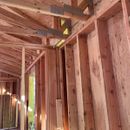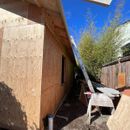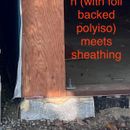Air sealing already-sheathed new construction?
Hi there. I’m building a 1200 sqft addition in the Seattle area (Zone 4 Marine/Coastal). I am attempting to use the sheathing as my primary air barrier, with Tyvek CommercialWrap as my WRB underneath 1.5” inches of rockwool, a 3/4” rainscreen/air gap, and Hardie plank siding. The plan is to use the Tyvek as a backup air barrier— taped (vertical seams) and sealed (Prosoco AirDam bead on underside of Tyvek at all horizontal seams [extending over the top and bottom plates/sills]). While I had my contractor caulk the mudsill to the foundation and fill exterior sheathing seams with Prosoco Joint & Seam, a miscommunication has left all plywood sheathing uncaulked to the rims, sills, and framing (it is, in many places, nailed to schedule as shear walls… maybe that makes it tighter?). I will not be conditioning or encapsulating the attic or crawlspace, so getting my air boundary appropriately “single unbroken line”-ed at the top and bottom of my exterior walls is, I think, fairly important. I’ve attached some photos as examples of the current state of the build.
Now that the sheathing is up and the roof is on — but framing is all still wide open on the inside— what’s the best way to seal my sheathing at the top and bottom edges?
And is there any point to air sealing sheathing wall seams at the gables (at least any taller/higher than the blown-in insulation in my attic will tend) if my attic will be vented?
Thanks in advanced! His community is amazing.
GBA Detail Library
A collection of one thousand construction details organized by climate and house part













Replies
Get a couple of rolls of 3m8067 and tape all the seams of the sheathing. This will also adhere to the foil faced rigid. From there I would install the house wrap in a regular manner, you can tape the seams but I don't think it will do much, sheathing as the main air barrier is much more effective. You can use also use the 3m tape to flash the window rough openings, I normally use 3" of the seams and 9" for the rough openings. Remember to lap the house wrap and flashing tape in the right order at the top and bottom of rough openings ( always shingle layers).
The transition from the wall sheathing the the interior ceiling air barrier will be harder. Usually the best way to do this is to have a strip of house wrap/tape over your wall top plates before the rafters are set to connect the two. The ship has sailed on this, I would caulk around the top plates and sheathing and seal the ceiling air barrier to the side of the top plate with acoustic caulk. Also make sure to seal any holes through the top plate for wiring or pluming. Same idea on the interior walls.
Vented roofs need intake vents at the soffit you'll need to drill some hole sin the top of the blocking between the trusses for this.
Polyiso is not meant to be buried, it can become saturated with water over time. No easy fix in your case, so I would make sure to that all liquid water is channeled well away from your foundation.
This is all very helpful. Thanks Akos!
(Edited to remove a question you already answered. It’s late and my mind is broken).
What’s the best kind of caulk for sealing the top plate to the sheathing between the truss cords— and I suppose for doing the same for the sheathing along the rim joist in the crawlspace? Is it worth getting something vapor open like Contega HF or my Prosoco stuff, or should I just use some DAP 230 or similar? I have some indoor-only GSIBaccouatical caulk but I suppose the attic and crawl are somewhere in between indoor and outdoor so might as well use an outdoor OK-ed product.
The polyiso is dual foam-faced, which I thought would help… but it’s recently gotten soaked at the seams (the plan is to flash over it but we haven’t gotten there yet). Hopefully it will dry out over time. Is the risk there simply that it becomes less effective when wet? We do have a nice footer drain, 18” eaves (could be bigger) and will slope away from the house as much as we can. We’ll probably end up putting a gravel path along the foundation for most of the house.
"What’s the best kind of caulk for sealing the top plate "
I would use a liquid flashing product. These are easier to apply and work better to bridge gaps.
"We’ll probably end up putting a gravel path along the foundation"
You don't want gravel as the top surface near any foundation. Lots of grave bellow is great but on the top you want something that will channel water away. This can be compacted limestone screening with pavers or a sloped concrete pathway. You always want to channel water away from the house, the goal is the least amount of water to make it to your weeping tile.
I don't know polyiso will hold up for a foundation. Saturated polyiso does loose R value, there is probably something on google out there about that. Most likely the water issues will probably be well bellow grade where the temperature delta is much smaller so it would be less of an issue.
Ah, and you can’t quite see it, but there are notches for the vents. Most of the blocking between the trusses has holes with screens but the spot I posted a pic of happens to have v-shaped notches at the top of the blocking instead.
Is the “ceiling air barrier” usually just drywall or is there a special product/procedure I should consider here? Want to make sure I get that right.
And the plan for flashing windows is a Prosoco system — AirDam to stick to the Tyvek and FastFlash. I do have a couple of rolls of 3m tape but I guess I thought it was a good idea to use vapor open materials where possible. I know flat sills are well served by non vapor open tape, but I figured I might as well just use vapor open adhesive products elsewhere. Speaking of, Tyvek with sealed seams really doesn’t do much in the way of air sealing? Should I just scrap my plan to make that my backup air barrier or is it possible it will add some benefit — especially for the older part of my house where we have shiplap sheathing and (photo attached). Everyone seems to suggest self adhering WRB for that, but I called siga and they said not to do it because of the large gaps caused by the shiplap so we gave up on that and are spending our time (and $$) filling the shiplap seams with Prosoco Joint and Seam (the siga rep said it will slowly get unadhered as air blows against it through the non-flat gap due to positive pressure in the house… seems crazy but he’s the product rep so what do I know).
"Is the “ceiling air barrier” usually just drywall or is there a special product"
Can be either. If the ceiling drywall is installed in an air tight manner (blocking around all the perimeter and caulk to seal) but it is a lot of work and your standard drywall crew will not want to do it.
Around me the ceiling air barrier is 6mil poly. Easy to install before hand, tape all the seams on it and seal it to your top plate with caulk. In warmer climates you want something that is somewhat vapor permeable, in this case you can look at Membrain or Intello.
"Tyvek with sealed seams really doesn’t do much in the way of air sealing"
Since it is not fully adhered to the surface you can get a lot of 3d airflow paths. It is possible to air seal with house wrap, but it is also very difficult to get it right and easy to damage it during siding install.
The best backup air barrier is installing your interior drywall in an airtight manner.
I'm not sure what the issue would be with the shiplap. I've used peel and stick (Henry VP100) for board sheathing and works very well. Probably bigger gaps than what you have. You can also nail up a new layer of OSB/CDX over the shiplap and treat that as your main air barrier. Sealing each board with liquid flash sounds like way too much work.
Is something like AeroBarrier out of the question?